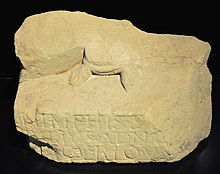Cohors III Aquitanorum
The Cohors III Aquitanorum [equitata] [civium Romanorum] [Philippiana] [Severiana] ( German 3rd cohort of the Aquitanians [partly mounted] [of the Roman citizens] [the Philippian] [the Severian] ) was a Roman auxiliary unit . It is evidenced by military diplomas , inscriptions and brick stamps.
Name components
- Aquitanorum : the Aquitaine . When the unit was set up, the soldiers of the cohort were recruited from the various Aquitaine tribes in the Roman province of Gallia Aquitania .
- equitata : partially mounted. The unit was a mixed association of infantry and cavalry. The addition occurs in the inscriptions ( CIL 13, 6493 , CIL 13, 6494 ).
- civium Romanorum : the Roman citizen. The soldiers of the unit had been granted Roman citizenship at one point in time. However, this did not apply to soldiers who were accepted into the unit after this point in time. They received Roman citizenship only with their honorable farewell ( Honesta missio ) after 25 years of service. The addition occurs in the inscriptions ( CIL 13, 6493 , CIL 13, 6494 ).
- Philippiana : the Philippian. An honorary title that refers to Philip Arabs (244–249). The addition appears in the inscription ( CIL 13, 6566 ).
- Severiana : the Severian. An honorary title that refers to Severus Alexander (222-235). The addition appears in the inscription ( CIL 13, 6568 ).
Since there is no evidence of the addition of milliaria (1000 men) to the name , the unit was a Cohors (quingenaria) equitata . The nominal strength of the cohort was 600 men (480 infantry and 120 horsemen), consisting of 6 centuries of infantry with 80 men each and 4 tower cavalry with 30 horsemen each.
history
The cohort was stationed in the provinces of Germania and Germania superior (in that order). It is listed on military diplomas for the years AD 74-134.
The first evidence of unity in Germania is based on a diploma dated 74. In the diploma, the cohort is listed as part of the troops (see Roman Armed Forces in Germania ) that were stationed in the province. Further diplomas, dated between 82 and 134, prove the unit in the same province (or from 90 in Germania superior ).
The cohort was probably stationed together with the Numerus Brittonum Elantiensium in the area of Neckarburken in the Elztal community since the beginning of the 2nd century ; each of the two units had its own warehouse there. Around 159/161 the cohort was moved to the Osterburken fort in the course of a shift of the Limes to the east .
The last proof of unity is based on the inscription ( CIL 13, 6566 ) which is dated to 244/249.
Locations
Locations of the cohort in Germania were possibly:
- Neckarburken forts : Several inscriptions have been found here.
- Kastell Osterburken : Several inscriptions were found here.
- Stockstadt Castle
Bricks with the unit's stamps were found in Obernburg am Main and Stockstadt.
Members of the cohort
The following members of the cohort are known.
Commanders
Others
See also
Web links
Individual evidence
- ^ A b John Spaul: Cohors² The evidence for and a short history of the auxiliary infantry units of the Imperial Roman Army , British Archaeological Reports 2000, BAR International Series (Book 841), ISBN 978-1841710464 , pp. 139-140, 147 -148
- ^ Jörg Scheuerbrandt : Exercitus. Tasks, organization and command structure of Roman armies during the imperial era. Dissertation, Albert-Ludwigs-Universität Freiburg im Breisgau 2003/2004, p. 159 table 3 ( PDF p. 161 ).
- ↑ Military diplomas of the years 74 ( CIL 16, 20 ), 82 ( CIL 16, 28 ), 90 ( CIL 16, 36 , RMD 5, 333 ), 116 ( CIL 16, 62 ) and 134 ( CIL 16, 80 ).
- ↑ Marcus Reuter : Studies on the numbers of the Roman Army in the Middle Imperial Era, Dissertation, In: Reports of the Roman-Germanic Commission 80, 1999, pp. 359-569, here pp. 446-447.
- ↑ brick temple: Obernburg am Main ( CIL 13, 12414 ), Stockstadt ( CIL 13, 12415 ).
